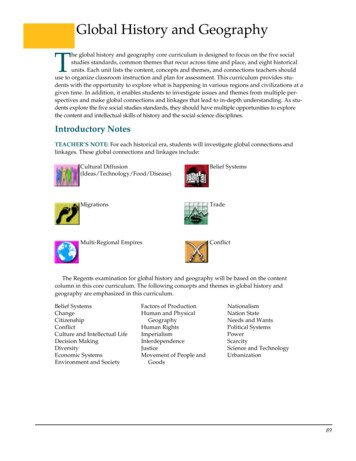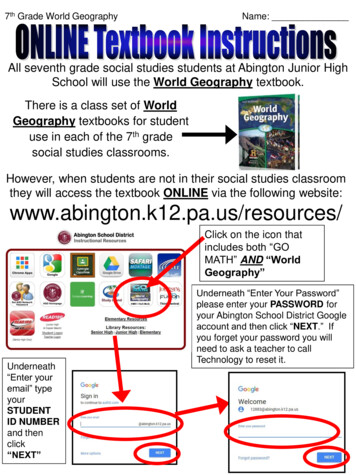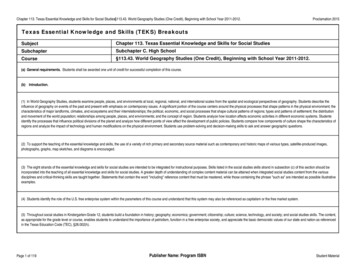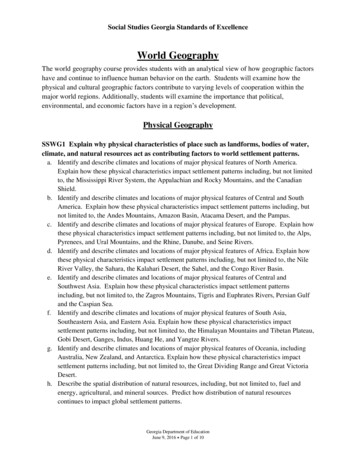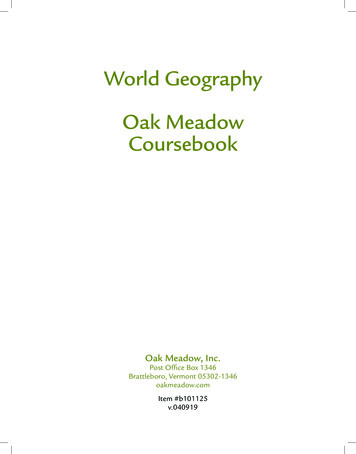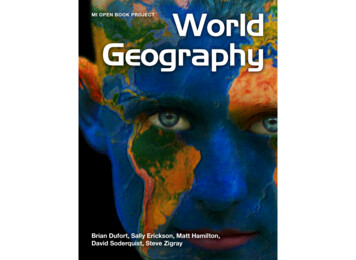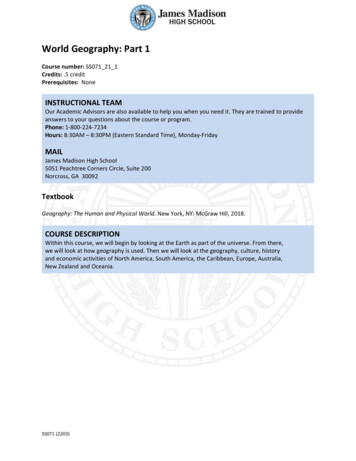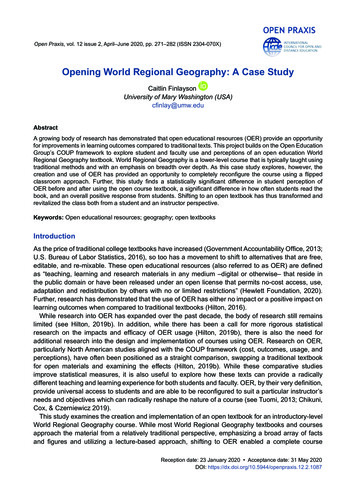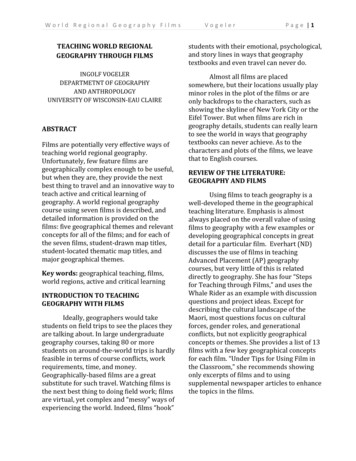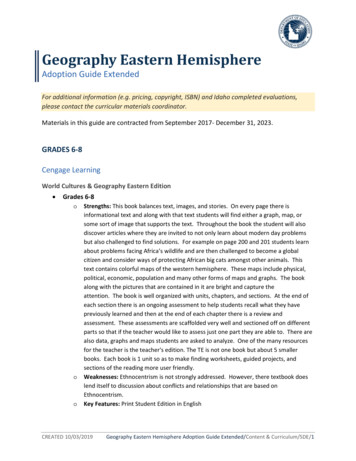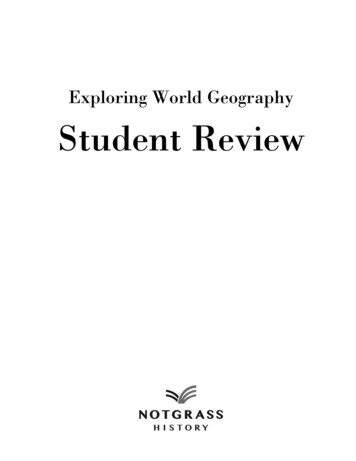
Transcription
Exploring World GeographyStudent Review
Exploring World Geography Student ReviewISBN 978-1-60999-159-3Copyright 2020 Notgrass History.All rights reserved.No part of this material may be reproduced without permission from the publisher.Review Questions and Literary Analysis by Bethany Poore(except Know Why You Believe analysis by Ray Notgrass)Cover design by Mary Evelyn McCurdyFront Cover: Lake Titicaca, Peru, by saiko3p / Shutterstock.comPrinted in the United States of AmericaNotgrass History975 Roaring River Rd.Gainesboro, TN 385621-800-211-8793notgrass.com
A Note to ParentsThe Exploring World Geography Student Review Pack is a tool to measure your student’sprogress as he or she studies Exploring World Geography. It includes three books: the StudentReview Book, the Quiz and Exam Book, and the Guide for Parents and Answer Key. This material isintended to enhance your student’s study of geography, the assigned literature, and worldview.Please do not let it become a burden. Students should focus on learning about the issues,the people, and the scope of world geography, as they enjoy the literature and the primarydocuments and grow in their understanding of worldview. We pray you and your student havea successful journey around the world!Student Review BookThe Student Review Book includes review questions on the lessons and most of the originalsources in the World Geography Gazetteer, map skills assignments, and literary analysis of andquestions on the twelve literature titles we suggest students read as they study Exploring WorldGeography. The material in the Student Review is arranged in the order in which a student willcome to it as they study the course. The assignment box at the end of each lesson in ExploringWorld Geography Part 1 and Part 2 prompts your student to refer to these components at theappropriate time.Review Questions. Many parents require their students to write out answers to thesequestions on paper or on a computer; however, that is certainly not required. Other parents andstudents discuss the questions orally, and some parents use them for family discussion.Map Skills Assignments. Students need to know how to use maps, what to look for and notlook for on maps, and how we carry around mental maps that can be accurate or inaccurate.These assignments will help your student become familiar with maps, both traditional mapsand digital maps we use in GPS devices and apps.Literary Analysis. We have carefully selected the literature titles that students read with thiscourse. If you want your student simply to read and enjoy the books, we think that is wonderful.If you would like them to dig a little deeper and analyze the literature, we included the tools forthat in this book. As we said above, please do not let any of this material become a burden.Following this Note to Parents, we have included “What Do You Think About What HeThinks? A Primer for Analysis of Non-Fiction” (to be read after Lesson 1) and “Who, What,How, Why, and Why Not: A Primer for Literary Analysis of Fiction” (to be read after Lesson36). Your student will be given a reminder when it is time for him or her to read these sections.Quiz and Exam BookThe Quiz and Exam Book contains geography quizzes and also periodic comprehensive examsin geography, literature, and worldview. The assignment box at the end of each fifth lesson inExploring World Geography Parts 1 and Part 2 prompts your student to take a quiz and to take thecomprehensive exams six times throughout the course. Each of these exams includes materialfrom five units. We have printed the Quiz and Exam Book on perforated pages so that you can tearout one at a time and have your student write directly on that piece of paper.Preparing for Quizzes. To prepare for a geography quiz, the student should study the reviewquestions and answers for the first four lessons from that unit.
Preparing for Exams. To prepare for the comprehensive exams in geography, English, andworldview, the student should review the following material:Geography: Students should study the quizzes and answers from the previousfive units.English: Students should review the literary analysis and questions for each bookthe student has completed during the previous five units.Worldview: Students should study the lesson review questions and answers fromthe worldview lesson of each of the previous five units (the last lesson in eachunit).We did not include questions on the readings from the Gazetteer on any quizzes orexams.Guide for Parents and Answer KeyThe Guide for Parents includes more detailed information on planning and grading the courseand notes about the literature titles that we assign. The Answer Key contains the answers to thereview questions, quizzes, and exams, as well as the answers to questions posed in the literaryanalysis and for one map skills assignment. The number in parentheses after an answer indicatesthe page number on which that answer is found in Exploring World Geography Part 1 and Part 2.
What Do You Think About What He Thinks?A Primer for Analysis of Non-FictionA non-fiction article, essay, or book has a different approach from a work of fiction. It willlikely make an argument, teach, or convey information. Of course, a work of fiction might alsobe an attempt to make an argument, teach, or convey information; but non-fiction presents theinformation and the author’s perspective in a straightforward manner. The non-fiction piecemight be in the form of a story; but it is a story from real life, as in a biography.Part of education is considering perspectives other than your own and developing yourresponse to them. In a persuasive work, a writer has something to say that he hopes others willat least consider and perhaps agree with. Even the author of a biography writes for a purpose,not only to inform but perhaps also to convince readers about something regarding his subject:that he was instrumental in a war, or influential in Congress, or had some other significantimpact.By reading a work of non-fiction, you might be confirmed in what you believe aboutsomething or you might be convinced that you need to change your opinion. You might obtainmore information that helps you have a more realistic perspective on an issue. You shouldn’tfear this process. You don’t want to cast aside basic truth and fall for every new idea you hear,but part of growing and maturing is gaining a more complete understanding of truth. No onehas a grasp of all truth or the perfect application of that truth in every situation. Everyone cangrow in some areas of life, whether that means learning more truth or learning the applicationof the truth you know to more situations. This process is part of growing in what the Bible callsdiscernment (see Hebrews 5:13-14).A text can be any written material. We analyze every text that we read, whether it is anencyclopedia article, a book of political commentary, or an advertisement, even if only brieflyand subconsciously. As with the analysis of fiction, we don’t want to lose the joy of reading byover-analyzing, but it is good to do serious and conscious analysis for several reasons. Analysiswill help you understand the meaning and purpose of a text; you might even discern a meaningbeneath the surface. It can help you connect the text with its background, such as the time inwhich it was written or something about the author. You can profitably compare the text withother texts to see which are more consistent and believable. Analyzing a text can help you provea thesis. A summary of a text is a report of its content, but an analysis of a text is an evaluationof its meaning and significance.In analyzing a work of non-fiction, you want to ask questions of the text. You probably won’tanswer every question below about every text, but here are things to consider when analyzingnon-fiction: What is the author’s point or purpose? What is the argument he is making? What is the motivation for the piece? What problem does it address? What evidence or logic does he use to support his thesis? What is the context from which the author writes (time, place, point of view, backgroundand experience)? What assumptions does the author bring to writing this piece?1
What words or ideas are repeated? These will often be clues to the author’s point. What word choices seem significant? Does the author use any figures of speech to makehis argument more persuasive? What is the structure of the text? For instance, The Art of War is a series of pithy observationsand bits of advice, Here I Stand is a scholarly biography, Bridge to the Sun is a memoir,and The Abolition of Man is based on a series of lectures. How does the author build hisargument through the work? How does the structure help make the author’s point? What are the key passages in the work, and why are they important? What is surprising, odd, or troubling in the text? (These parts are likely challenging yourcurrent understanding.) What contradictions and inconsistencies do you find in the text? What assumptions do you bring to the text? Is the text convincing to you? Why or why not? (It is entirely likely that you will agreewith some things and disagree with others.) What questions do you have after reading it? What further study do you need to do?When you write an analysis of a non-fiction work, gather your information, impressions, andanswers to these questions, then write a coherent essay that responds to the piece. Dependingon the length of your essay, you will probably want to summarize the author’s purpose andargument, emphasize the central points as you see them, note where you think the author iscorrect and where he is mistaken, and where he is effective and where he could have expressedhis ideas differently. Keep in mind the nature of your assignment, what the teacher expectsfrom you, and what the reader of your analysis needs to understand about the work you areanalyzing and about your response to it.The author whose work you have read wants you to think. Show that you have thought.Expressing your thoughts on paper indicates how well you understand what he has said and,more importantly, how well you understand your own thoughts about the subject.Analysis of PoetryYou cannot read poetry the way you read a novel, a newspaper, a textbook, or other nonfiction writing. Poetry aims for the heart, for an emotional response, as well as for the mind.Poetry is concentrated language, so how the poem expresses thoughts is extremely important.Don’t be afraid to read a poem aloud and slowly. You will probably have to read it more thanonce to grasp its message fully.As you read a poem, ask these questions: Who is speaking? Is the poem first-person, or is it a third-person speaker? What is the occasion? Is it a monologue of one person speaking to another? Is it an elegy or a remembrancehonoring the dead? Is it a lyric or an ode that meditates on a particular subject? Is it anarrative poem that tells a story?2
What is the tone, the mood, the atmosphere that the poem expresses? Does it suggestfloating through the air? Is it a dirge or lament? Does it have a military beat? Does itexpress longing or joyful praise? Is the language of the poem stately, colloquial, humorous, or mysterious, or can youcharacterize it in another way? What literary techniques does the poet use (see the list in the analysis of fiction)? Are there important thoughts that are unexpressed in the poem, such as any backgroundinformation that it assumes? Is it effective in generating the desired emotion, attitude, or memory in you?Poetry traditionally utilizes the rhythm of words, called meter. The determination of meter iscalled scansion or scanning the lines. Traditional poetry also uses rhyme to produce a particularemotion. Rhyming can occur at the end of lines (end rhyme) or within lines (internal rhyme).Approximate rhyme uses words that sound similar but do not rhyme exactly. Blank verse has adefined rhythm but does not rhyme. Free verse does not use consistent rhyme or meter. At thispoint, simply take note of how the poem’s use of words, rhyme, and rhythm affect you.When you are called upon to analyze a poem, use your responses to these questions to writean essay that addresses the main points of the poem. Analysis tends to focus on the mind, butremember to include your heart-response to the poem as well.3
Who, What, How, Why, and Why Not:A Primer for Literary Analysis of FictionPeople read books. Some books (think Shakespeare, Charles Dickens, and Jane Austen) arestill widely read decades and even centuries after they were written. Many, many books (thinkof the highly forgettable ones you see in used book sales—over and over) are a flash in the panor are even less noticeable. What’s the difference? Is it just that most people like this book andmost people dislike that one? Sort of, but it is more nuanced than that.Literary analysis is studying the parts of a work of literature (such as plot, setting, characters,and narration) to see how the author uses them to create the overall meaning of the work as awhole. Professors, teachers, students, critics, and everyday people analyze works of literature:novels, short stories, poems, and non-fiction. They think about the story or plot of the book, howit develops, the characters in the book, the words and structure that the author uses, and otherelements of the work.People who analyze literature have developed standard methods. Primarily, this involveslooking for elements that are found in most literary works. The purpose of literary analysis is tounderstand how a piece of literature works: how the writer constructs his or her story, and whythe work affects readers the way it does.Did you ever see yourself doing literary analysis? Does the phrase “literary analysis” makewashing dishes or chopping firewood seem exciting? I understand. But it is more interestingthan it might sound. Think of it as finding the answers to some big questions: “What makes astory good?” “What are the building blocks of great writing?” “Why do I keep thinking aboutthat book and want to read it again?” “What is the difference between a book you stay up lateto read and one that should be repurposed as a fire starter?” Even if you don’t want to make alifelong habit of literary analysis, as an educated person you should know the basics of how itworks. It can also be kind of fun.Literary analysis can help you appreciate the power of a work of literature. It can provideyou with insights for a deeper appreciation of the next novel (or poem or history) you read. Ona practical level, literary analysis is often what a classroom teacher wants students to do in orderto understand a book. So literary analysis is good as long as it is a means to a good end andachieves a worthy goal. However, if literary analysis becomes an end in itself, or a way to showhow much someone knows or thinks he knows about literature, or something that gets in theway of enjoying a work of literature, it no longer serves a good purpose. In other words, literaryanalysis has its place; but it is not the purpose of literature.Writers do not write in order to have their work subjected to literary analysis. NathanielHawthorne did not write The Scarlet Letter, nor did Charles Dickens write A Tale of Two Cities, forEnglish teachers to analyze them to death or so that professors would have material for exams.They wrote because they had stories to tell; they wanted to connect on an emotional level withreaders. These authors were successful because they did that well, and this is why their booksare considered classic works of literature.Here are some standard elements of literary analysis.PlotThe plot is the story of a piece of fiction. Fiction is a work of imagined narrated prose, usuallyeither a novel or a short story. The plot is what happens to make it a story.4
Gustav Freytag was a nineteenth-century German novelist who found a typical patternof plot development in Greek and Shakespearean dramas. The same pattern is found in mostfictional literature. Freytag depicted it as a pyramid.ActiingRisonExposition(including Narrative Hook)tiAcngInciting IncidentliFalonClimaxResolutionDenouementThe examples below refer to The Lion, the Witch, and the Wardrobe.Exposition: laying out the situation and background, introducing the characters. (Within thiselement will often be a narrative hook, an event or description that gets you interested in the story andwanting to read more.) Four children come to stay in a professor’s country home. The narrativehook is when Lucy finds a magic wardrobe in a back room and visits Narnia: what will happennext?Inciting incident: something that gets the story moving.Lucy meets the faun, who expresses inner conflict over what he is doing.Rising action: building drama; each significant event is called a complication.All four children go to Narnia, they meet the Beavers, Edmund betrays his siblings to the WhiteWitch, and so forth.Climax: the single key event or turning point; the moment of greatest tension.Aslan sacrifices his life on behalf of Edmund.Falling action: events that occur as a result of the climax.The good and evil creatures in Narnia have a battle.Resolution: the event in which the main issue is resolved.Aslan’s side wins. The four children are established as kings and queens.Denouement (day-new-maw): the finishing out and tying up of the details of the story.The four children grow up, rule Narnia, and then return to their own world.Freytag’s Pyramid is only a typical plot development. It accurately describes the plots ofmany pieces of fiction, but there are many variations and exceptions. Writers do not necessarilywrite to the Freytag Pyramid. Don’t try to force a work into the pyramid if it doesn’t seem tofit. In addition, people will sometimes have different ideas about what is the narrative hook,inciting incident, resolution, or even the climax in a really dramatic story.The key question to ask about the plot of a piece of literature is, “What is the conflict?”What is the issue that the main character needs to resolve? Is it conflict within himself, perhapsbetween what he wants and what he actually has? Is it a conflict between himself and anothercharacter, or between himself and the expectations of others? Is it the conflict of wanting to reacha goal but being unable to do so? What keeps or moves the character out of stability and causestension? The tension between Pip and Estella is one conflict in Great Expectations. The quest forthe ring is a continuing conflict in The Hobbit and The Lord of the Rings trilogy. A skillful writer5
might have several lines of conflict in a work and interweave them into a gripping narrative.Conflict and struggle are how we grow as persons, so the conflict in a story is an important wayfor us to identify with the characters in the story.The time, place, and social environment of a story is the setting. The plot unfolds in thesesurroundings. Is the story set among the working class of early ninteenth-century England,among fishermen of first-century Israel, among slaves in the southern United States just beforethe Civil War, or among homeschooling families of twenty-first century America? The settingwill affect what characters know, their assumptions and aspirations, and how they act andspeak. The geographic setting always impacts the development of the story: isolated mountainvillagers will act and speak differently from urban dwellers. The rural and urban settings—andthe conflict between them—in Cry, the Beloved Country are crucial to the story.Another key element of the plot is the structure of the story, how it is told. A straightchronological narrative is simplest, but an author might want to use flashbacks (descriptions ofevents that happened earlier, out of chronological order) and foreshadowings (hints at thingsthat will come later) to convey attributes of characters or particular feelings to the story.Archetypes (ARK-eh-types) are typical or standard plot elements, such as a character on aquest, the pursuit of an elusive goal, the loss of innocence, or an initiation into a new situation.Many of the world’s most famous works of literature include one or more of these elementsbecause these situations make for a good story. Everyone goes through these times or has thesedreams.Characters and Characterization The characters are the people in a story. The protagonist is the main character of the story (Jo in Little Women). The antagonist is the character who works against the protagonist and provides somedegree of conflict (the White Witch in The Lion, the Witch, and the Wardrobe). The confidant is someone to whom a character reveals his thoughts and motives (Margaretplays this role for Bessy and Mr. Bell plays this role for Margaret in North and South). The mentor teaches another character about life (Marmee in Little Women). A foil is often a minor character who by being a contrast illuminates another character(for instance, the slick operator who serves to highlight the integrity of the protagonist). Other typical characters are the hero (Sir Percy Blakeney, the Scarlet Pimpernel), thescapegoat (Tom Robinson in To Kill a Mockingbird), and the buddy pair (Don Quixoteand Sancho Panza). A round character is three-dimensional, one whose personality is well-developed andwho has some internal struggles expressed. In other words, he is believable and realistic.David Copperfield is a round character. A flat character is not developed in the story(Jethro in The Cat of Bubastes). A stock character portrays a stereotypical role, such as thecruel stepmother in Cinderella, the slow and dimwitted policeman, or the unemotionalaccountant. A stock character might be round or flat. A dynamic character changes duringthe story (matures or regresses, as Margaret Hale does in North and South), while a staticcharacter does not change (Fanny in North and South). A good author uses each characterto advance the story in some way, not just to clutter the pages.6
Characterization is the way that the author reveals the nature and personality of thecharacters. This is how the author makes a character real. What do you learn about a characterin the course of the story? How do you learn about him or her? The narrator might tell the readerabout a character (direct characterization), or the author might reveal a character’s attributesby what the character says or does (indirect characterization). Typical methods of indirectcharacterization include a character’s actions and his effect on others, a character’s dress andappearance, how he talks and what he says, and the thoughts he reveals. The author mightconvey information about a character through his interactions with others, by what others sayabout the character, or by discrepancies between the character’s reputation and his real actionsor between what he says and what he does. A narrator (and through the narrator the author)might express an evaluation of a character by comments he or she makes. If a character growsor changes, how does the author show this: insights that she gains, experiences that teach herlessons, or by demonstrating different ways of acting or speaking over the course of the story?Conflict within a character or between characters can be distinct from conflict in the story.In A Tale of Two Cities, for example, the conflict between the Defarges and the other Frenchrevolutionaries on one hand and the French aristocracy on the other is different from the conflictwithin Sydney Carton himself. What does a character do about conflict? Does he try to escape it,does he repress it, or does he address it?NarrativeThe Narrator. Who is telling the story? One key element of the narrative is the point of viewof the narrator. The narrator might be first person, a character in the story. A first person narratormight be a major or a minor character in the story. The character David Copperfield is the firstperson narrator of the Charles Dickens novel by that name; the first-person narrator Ishmael inMoby Dick is a relatively minor character in that book. A narrator might be third person, one whois not a character in the story. The narrator might be omniscient, meaning that he or she knowsthe thoughts and motives of each character, or he might be limited omniscient, knowing thethoughts and motives of just one person. A narrator might be objective, not knowing anythingabout the inner thoughts of the characters except what the characters themselves reveal. Oneway to describe an objective narrator is that he knows and conveys only what a camera sees. Arare form of narration is second person, by which the author describes the reader himself goingthrough the events of the story. Another rare form of narration is the stream of consciousnessapproach, in which the narrator relates the jumble of his own (or one character’s own) thoughts asthey occur to him. William Faulkner’s The Sound and the Fury is told in a stream of consciousnessapproach.An author chooses the narrative approach for a reason. In Great Expectations, the reader hasmuch more sympathy for Pip, the main character and first person narrator, than he would ifthe story were told by a third person narrator, although Dickens used third person narrators inmany of his works.Narrative Mood. What is the mood or tone of the narration? Is the narrator light-hearted,angry, skeptical, condescending, or sad and defeated? The mood of the characters might bedifferent from the tone the author conveys. The characters might be harsh and judgmental,but the narrator could be sympathetic to the victims of the harshness. Simon Legree is a harshcharacter in Uncle Tom’s Cabin; but the author/narrator Harriet Beecher Stowe is sympatheticto Tom, the target of Simon’s harshness. The author might have an agenda or cause he is tryingto get across through the way the book is narrated. A rare approach is the unreliable narrator7
who is so prejudiced that the reader cannot trust what the narrator says and has to filter whatthe narrator says to determine the truth. It is possible for an author to have a tone or agendathat is different from the tone or agenda of the narrator. For instance, the author might want tocondemn the lifestyle of the rich and famous. To do so he makes the narrator so fawning towardand accepting of the rich and famous that it turns the reader off. This is a subtle form of sarcasmas a tone.Narrative Style. An author will use a particular style, such as formal or colloquial language,or take a logical or emotional approach to the story. Does the author use dialog, which is therecording of direct quotes of conversations between characters, to advance the story?Literary Techniques. How does the author use words to tell his story? He has several toolsat his disposal. Imagery is using descriptive language to convey appearance or other attributes. It ispainting pictures with words. Compare “We walked between two large rocks and cameto a big field” to “The narrow passage between the towering cliffs opened into a meadowlush with wildflowers.” Simile is a comparison using like or as. “His encouragement was like a breath of freshair to me.” Metaphor is a comparison in which one thing is said to be another. “You are a rock ofstability to me.” Symbolism is the use of one thing to represent another. Literature often uses archetypicalsymbols to convey certain ideas: night often portrays mystery or evil; a mountain canrepresent an obstacle to overcome; winter and spring can represent death and rebirth. Allegory is an extended comparison, in which every or almost every character or eventrepresents something else. Animal Farm is an allegory of the Russian Revolution. Apostrophe is addressing someone who is not present or something that is not human.“Caesar, thou are revenged” (from Julius Caesar, spoken after Caesar was dead). Synecdoche (sih-NEK-doh-key) is using a part for the whole. “Ten thousand feet marcheddown the street to an endless beat of drums” (people marched, not just feet). Metonymy (meh-TONN-eh-mi) is substituting one term for another because of the closeassociation between the two. “The White House announced a new economic stimuluspackage today” (meaning the President or an administration official did so, not thephysical structure at 1600 Pennsylvania Avenue in Washington, D.C.). Hyperbole is intentional overstatement. “I think of you a million times a day.” Litotes (LIH-tuh-teez) is intentional understatement. “His donation to the charity wasnot insignificant” (meaning it was significant). Irony is a contrast between appearance and reality. Irony can be situational (a manproposing marriage to a woman in a comical setting such as being stuck in a elevator,or characters trying to keep from laughing out loud in a quiet museum), verbal (onecharacter doing something foolish and another character saying the opposite, such as,“That was an intelligent thing to do!”), or dramatic (the reader knows more than thecharacter does, so the reader knows that it is ironic that the character is doing this becauseit is fruitless or dangerous).8
Oxymoron (ox-ee-MORE-on) is a contradiction in terms. “The silence was deafening.” Paradox is a phrase or statement that appears to be contradictory but in fact might conveya deep truth. “I know that I know nothing at all.” Antithesis is putting together two opposite ideas to achieve the effect of a contrast. “Itwas the best of times, it was the worst of times.” Personification is the giving of human traits to non-human things. “The trees waitedeagerly for the rising of the sun.” Alliteration is the repetition of the same initial verbal sound. “Billy bounced a ball bythe backyard barbecue.” To be more specific: assonance is the repetition of the samevowel sound; consonance is the repetition of the same consonant sound. Alliterationgives rhythm to a statement
A Note to Parents The Exploring World Geography Student Review Pack is a tool to measure your student’s progress as he or she studies Exploring World Geography.It includes three books: the Student Review Book, the Quiz and Exam Book, and the Guide for Parents and Answer Key.This material is intended to enhance your stud
